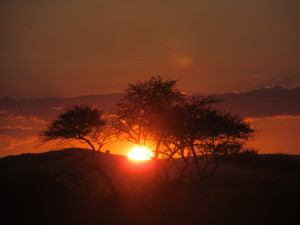Canton High School travel pioneers prepare for field research in South Africa
By Candace ParisCanton High School junior Ben Cohen believes that once-in-a-lifetime opportunities should not be ignored. Initially skeptical about submitting an application to participate in biology teacher Rebecca Stang’s expedition to a South African wildlife reserve, he soon overcame his reluctance. Now he is very excited about the February trip, a feeling shared by at least two other students on the trip roster, senior Renee Semple and junior Addison Mirliani.
Stang herself has been anticipating the trip for a long time. She has been thinking about the possibility of taking students on a research trip ever since returning from a field research expedition to the Galapagos Islands two years ago. Stang said her project focused on “charting the effects of human activity on the evolution of the famous Darwin’s Finches, particularly upon the evolution of their beaks.” When students heard of her experiences, they immediately asked how they could get the chance to do field research. That started Stang down the road to figure out, as she puts it, “what is needed to make it happen.”
She embarked on a six-month-long search for sites and programs that would welcome Canton students and meet her exacting standards. Most scientific research programs won’t even consider allowing high school students to participate. Stang also knew she wanted a program that would involve “actual science with real results” so the students could experience both the rigorous methods and the rewards of research. Location was important to minimize travel time and to allow access to any needed emergency medical services. Finally, Stang found a small wildlife reserve not far from Johannesburg with a well-established program. She said, “This site is perfect in every way.”
Stang presented her plan for approval by three successive entities: high school administration, district administration, and the School Committee. After she was given the green light, in the late fall of 2015 she invited students to attend an informational meeting about the trip and submit applications. Semple knew immediately that she would apply, as did Mirliani, whose mother is on the School Committee and shared her excitement about the prospect. Cohen concedes that his father may have contributed to his change of heart.
All applications were screened, including for minimum requirements such as grades, school attendance and successful completion of biology. The limited number of sleeping spaces available at the reserve meant that some qualified students had to be turned away; in the end, a total of 13 sophomores, juniors and seniors were named as participants.
The group will be also be accompanied by Joel Chamberlain, a history teacher at CHS. Stang said he can provide the students with perspective on South Africa’s complicated history, a topic some are already familiar with from their studies. The tight schedule won’t permit visiting the Apartheid Museum or Soweto, but there may be time to visit an anthropological museum.
The focus is on science, specifically active involvement with ongoing research projects being conducted at the reserve by scientists from the University of Brighton (UK). Rhinos, which are seriously endangered, are one of the large mammals being studied; one project addresses the effects of de-horning on their behavior. (De-horning is a conservation technique designed to protect rhinos from poachers who hunt them for their horns.) Stang also mentioned studies on dung beetles, general populations conservation, and the impact on the ecosystem if rhinos are removed as projects the students may assist with, depending in part on the weather.
All of this is very attractive to Semple, who loves science and travel. “I’m just excited to be immersed in nature,” she said. “I’m a nature geek.”
Like the others, she has made sure she has quality hiking boots for the daily average of three miles of hiking required for project work. The students will indeed be surrounded by nature, with a wide variety of animals living in the reserve, including hyenas, giraffes, and Mirliani’s favorite, zebras. Although sleeping accommodations are rustic tents and cabins, the reserve’s chef will provide meals. That appeals to Cohen, who said he is eager to try South African food.
In the final weeks before departure on February 13, Stang said she will call more team meetings. Some of the students already know each other well, but Mirliani said, “It will be nice to get to know the people on the trip I don’t already know.” The students will be packing for themselves as well as the school supplies they collected through a donation drive for a school they will visit in Rustenburg. Some may need to prepare for sleeping on the long trip to be ready to start work on day one. After flying to London, they will catch a 10-hour flight to Johannesburg. On their morning’s arrival, they will be transported a couple hours to the reserve and immediately begin work.
The pioneering group will be able to share their life-changing experiences with other students and the community through journals and photographs. (Some of these will be published in the Canton Citizen.) Canton student groups have traveled to Europe in the past, but helping to conserve endangered species in Africa is a first. Stang’s own passion for working with students and for biological field research plus her long connections with Boston-based nonprofit Earthwatch, the umbrella organization, are enabling her to provide her team with a distinctive, stimulating experience.
Short URL: https://www.thecantoncitizen.com/?p=35210











